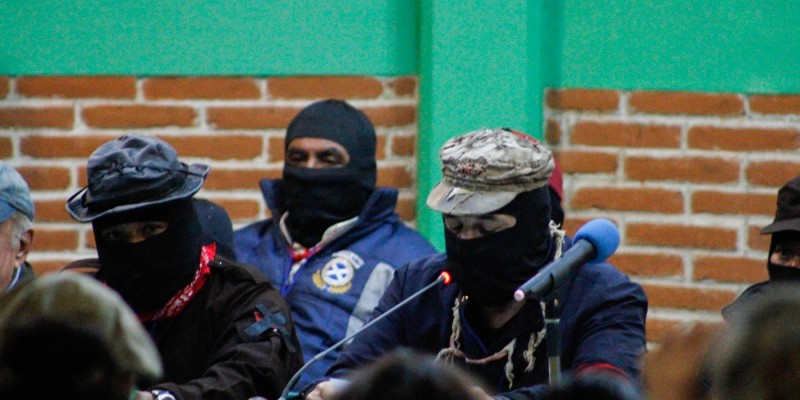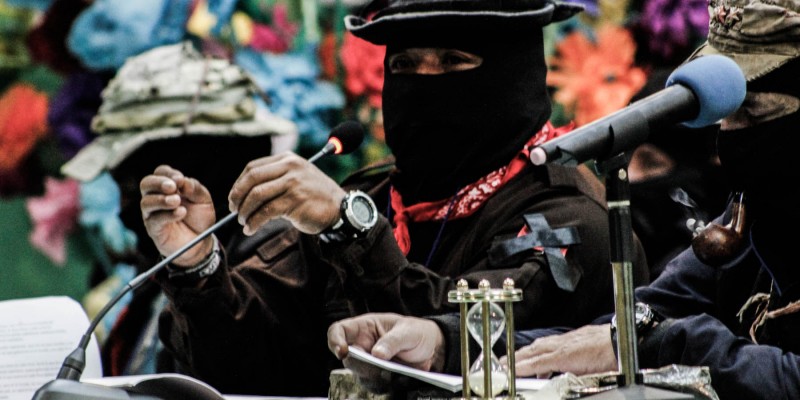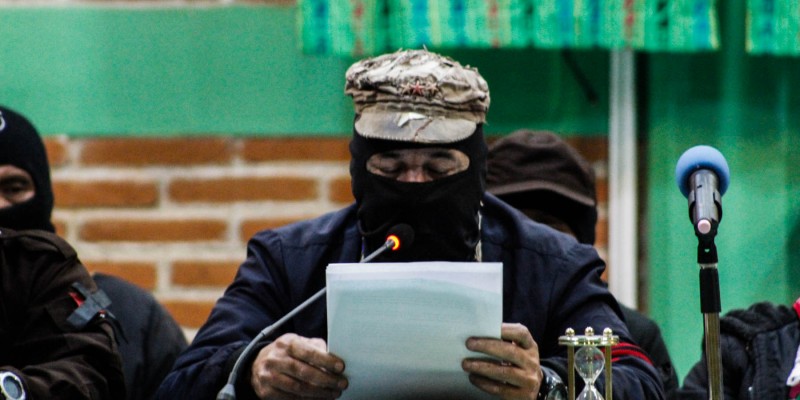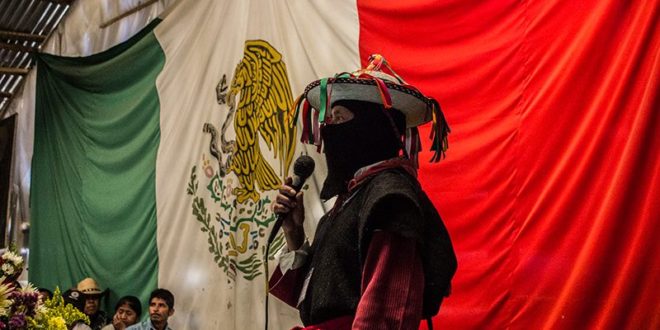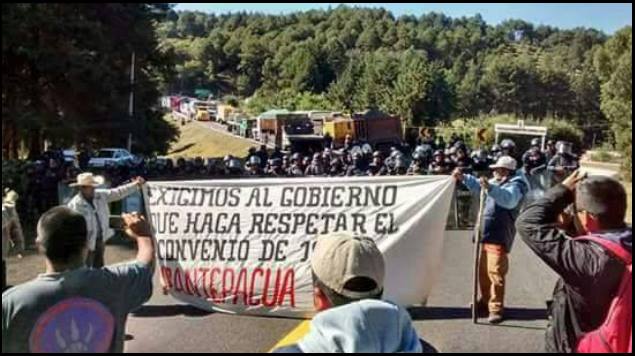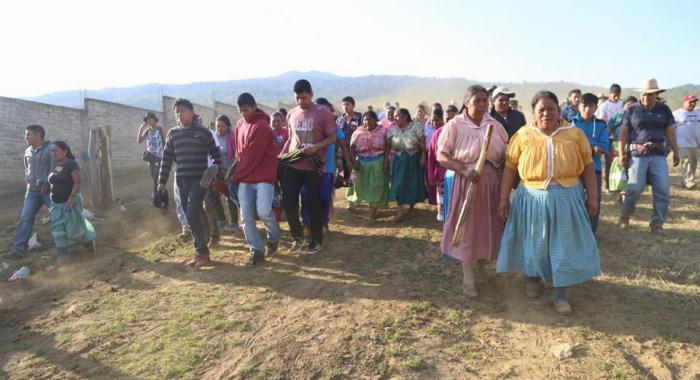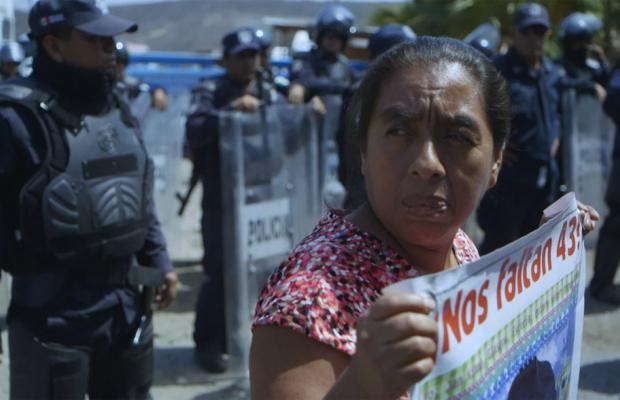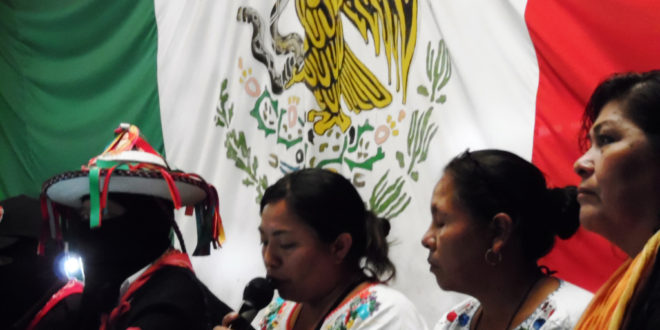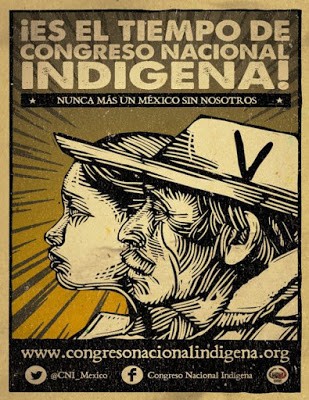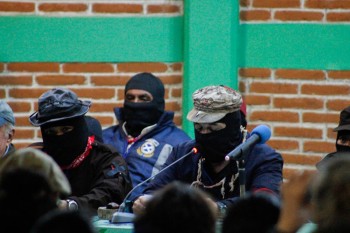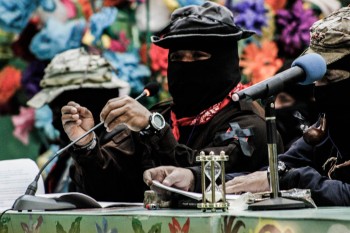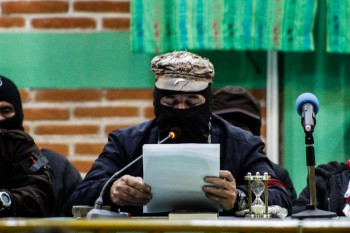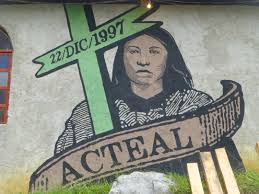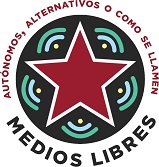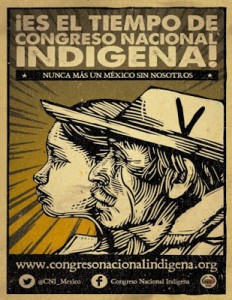
Kagemusha: April is Also Tomorrow – Subcomandante Insurgente Galeano
KAGEMUSHA: APRIL IS ALSO TOMORROW.
Seminar “The Walls of Capital, the Cracks of the Left”
Cideci / Universidad de la Tierra Chiapas
April 12, 2017
(Descarga aquí)
A few months ago, Subcomandante Insurgente Moisés gave me a more extensive and substantive summary of what he just told you.
Perhaps unintentionally, he had detected a through line between the past and the storm that’s here now.
Early this morning, after listening to the stories—told through the voice of SupMoy—of the oldest of our compañeros, I returned to my hut. In any case, an unseasonal rain had begun to lash the tin roof, and it was impossible to hear anything beside the storm.
I continued rummaging through the trunk that SupMarcos had entrusted to me, because I thought I had seen a text that might relate to what I had just heard.
Reviewing those writings is not easy, believe me. Most of the texts piled in disarray in that trunk date from 1983 to January 1, 1994, and it’s clear that at least until 1992, the Sup not only did not have a computer, he didn’t even have a mechanical typewriter. So the texts are handwritten on pages of all sizes. The deceased’s handwriting was far from legible in any case, in addition to the impact of the time in the mountains, humidity, and tobacco stains and burns.
There’s all kinds of things in there. For example, I found the original manuscript with the operating orders for the different Zapatista military units on the eve of the uprising. Not only do they contain each unit’s makeup, but also each operation, detailed with a thoroughness that reveals years of preparation.
These are not the notes of a poet lost in the mountains of the Mexican southeast, or of a storyteller. They’re the writings of a soldier. No, better said, of a military commander.
The Capitalist World is a Walled Plantation – Subcomandante Insurgente Moisés
The Capitalist World is a Walled Plantation
Words of Subcomandante Insurgente Moisés
Seminar “The Walls of Capital, the Cracks of the Left”
Cideci / Universidad de la Tierra Chiapas
Wednesday April 12, 2017
(Descarga aquí)
Good evening, good afternoon, good morning, according to where you’re listening from.
Brothers, sisters, compañeros, compañeras:
What I’m going to talk about today is not what I believe, but rather what our great-grandfathers and grandfathers and great-grandmothers and grandmothers told us.
I talked with one of our great-grandfathers who says he’s 140 years old. According to my calculations he’s around 125 years old. You have to get very close to his ear for him to be able to hear what you ask him.
I spoke with about 20-some of them, of our great-grandfathers and great-grandmothers. We were asking them– the compañeros from the Clandestine Committee were there too–and it turns out that part of what SupGaleano was saying is exactly what they told us about.
For example, for the bricks that they used to make for the plantation owners—that is, the owners of the haciendas, the hacendados they call them, or the patrón—they had to fill large sacks with horse manure. Then they dried them, and after having dried the sacks of manure, they turned the manure into dust using a heavy club to beat the sacks. Then they mixed that with mud to make the adobe bricks with which they built the plantation owner’s house.
This great-grandfather said that he remembers that the work was organized by quota. Quota means that each one of them had to turn in a certain number of sacks. So each time there was fresh horse manure, they had to bring it, with the water running down their backs. The point is that they had to turn in the number of sacks that the patrón demanded.
They learned how to make their own houses that way too, they used the same materials. They called it mud wall, mud construction is what it’s called. So, they learned to build this way, but their houses were much smaller, with just two rooms.
So, what I’m going to explain here further is where our ideas come from, as the Zapatistas we are—what we’re seeing and studying about how we are exploited today. In sum, I’m going to tell you this because this is what is going to help us to understand what happened before and what situation we’re in now, and what the future will hold.
Our grandfathers and great-grandfathers, great-grandmothers and grandmothers tell us that the patrón is the owner of the plantation,of many plantations, many haciendas. All the plantation-owners have their managers [caporales], foremen [mayordomos], and overseers [capataces]: those three, well four with the patrón.
They tell us that there are plantations of fifteen thousand hectares, of twenty thousand and twenty-five thousand hectares. There are plantations with different kinds of work, and some plantations that only produce one thing, like coffee. There are others that produce coffee, livestock, corn, beans, sugar, and lots of different things.
They tell us, too, about the methods of exploitation. They tell us that there are plantation owners, landowners, who never paid them anything, and they gave their whole lives to work. Others tell us that Sunday was the only day they had for themselves; all the other days were for the patrón. Still others tell us that they worked one week for the patrón and one week for themselves. But that it was a trick, a swindle, they tell us, because that week our great-grandfathers and great-grandmothers supposedly had for themselves, whatever they harvested that week (whether it was beans, corn, or a few animals they were able pull together), when it came time to sell, they had to give half to the patrón and they kept the other half.
They tell us that when the patrón wants to see if his herd of animals is complete, they had to go and get them, herding the animals and putting them in the corral. They tell us that if one of the patrón’s animals was missing, they had to go look for it and bring it back, dead or alive. How did the patrón, that is, the landowner, require that they prove that it was dead? They had to bring back a piece of its hide so that the patrón would know for sure that his animal was dead. If they couldn’t find it, they had to keep looking until they found it, dead or alive.
When the patrón took the livestock to market, he organized the workers into groups who were responsible for so many heads of livestock. Whether it was ten or twenty people, men, they had so many heads of livestock that they had to transport. The patrón would count them before leaving and he count them again upon arrival at the destination where the animals were taken. Each person had to deliver all of their livestock; if they didn’t account for every single one, they would have to pay for it, or the person in charge of that group would.
They tell us that the corral, if the patrón so desires, is made of stone. If not, it’s made of wood carved with an axe. And they say that it had to be pure heartwood. That means that it’s the hardest part of the wood, so that it doesn’t rot later. The patrón wouldn’t accept softer wood, he would refuse it.
They also tell us that when it was time to take the pigs to market (not the patrón, the animal: the hogs) it was the same process as with the cattle. But there was a difference, say the grandfathers and the great-grandfathers. They say they had to transport the load at night, because the hogs get overheated during the day. So their flashlight, their light source, was a torch made of ocote wood.[i] They carried bundles of ocote as their lamp to walk by night. The same as with the cows, each person was responsible for a certain number of pigs. And if they wanted to advance by day, they had to carry water with them to wet the hogs down, that is, to cool them off so they didn’t suffer in the heat.
The women, the grandmothers and the great grandmothers, tell us that the patrón had his way of how he liked things done. For example, the grandmothers and great-grandmothers say that when the work was difficult, it was always the married women who had to do it. What was their job? To grind coffee, to grind salt in bulk. They tell us that the mothers went with their children to grind salt, with a flat stone for grinding, a metate. And the managers, foremen, and overseers were right there, as well as the patrón and his wife. The women had their babies on their backs but weren’t allowed to take care of them, even though they cried and cried, because the patrón was there watching and the women had to meet their quota. It wasn’t until the patrón or his wife decided to go use the bathroom that the mother would have a chance to breastfeed her child.
They tell us that the patrón would ask for only young women to attend to him in his plantation house, to do different jobs. But one of the patrón’s tricks was to choose a young woman and say, “You, I want you to go and make up my bedroom,” to make the bed. And when the young woman went into the room, the patrón would follow to rape her. So he chose them one by one. And they tell us too that he would grab them whenever he wanted to.
They tell us also about what I already mentioned, that they were there grinding the coffee, grinding the salt, and the pay that the patrón would give them was three pieces of beef, but from animals that were already dead. That was their payment.
They also tell us that the children were given work too. No one escaped it. They called them porteros, keepers, but not the keepers like in soccer, they just called the children that. The job of those six-year-old children was to grind the nixtamal [partially cooked maize] without lime; this was for the dogs, the pigs, and the chickens. Once that was done they had to carry water, usually in a barrel on their backs we are told. The barrel was made of wood in which they would make a hole, that is, they would perforate it. The barrel held between 18 and 20 liters, and this is what the children had to carry so the patrón could wash his hands, use it to bathe, or whatever he wanted. Once that was finished, the children had to go and carry wood. After they brought the wood, they were responsible for de-kerneling the corn.
The elders tell us also that once the men got old and couldn’t work in the fields, and the older women too…well, nobody was free from work. The older men would go look for a plant that we call “ixchte.” The men would scrape it until a kind of thread was formed. One group would do this part. Another group of older men would then make the thread into a kind of rope. Another group would be responsible for turning that into nets. That was the work of the old men. And the older women? One group would be responsible for unraveling cotton. Another group would turn the cotton into thread and another group would weave the thread into cloth. And then that little piece of cloth is what our great-grandfathers and great-grandmothers would later have to buy to use as clothes. They tell us that the clothes they wore were just to cover the most necessary parts, nothing else, not like we are dressed today.
They also told us about punishment. There were various kinds of punishment. One was that the patrón would have some corn mixed with beans, and he would throw it on the ground and tell you to separate the corn from the beans. And the patrón knew—the elders tell us—that you weren’t going to be able to do it, because he would give you a a time limit. He’s say: “I’m going to spit and in the time that it takes my saliva to dry is the time you have to separate the corn from the beans.” But how were you going to pull that off?
Since you couldn’t possibly do this, there close by the patrón would have gathered some little rocks together, prepared a little piece of ground with rocks. That’s where he would make you kneel because you couldn’t separate the beans from the corn. So you had to kneel there and you couldn’t get up until the patrón decided to let you. And if you got up, that meant you were not accepting your punishment. So you had to endure kneeling there and thats where the whip came in. I’m going to tell you exactly what the grandfathers told me. They said that whenever one of the patrón’s bulls died, he’d have the penis cut off the bull, dried, and that’s what he used to whip the workers. So while you’re kneeling there, the patrón would come whip you and you couldn’t get up because—this is what they tell us—if you got up it would be worse. But they tell us that you had to get up because of the pain from the whip and and the pain from your knees—that it was intolerable and you just had to get up.
But the moment you got up, there were the managers, the foremen, and the overseers to grab you and tie your hands and feet to the beams of the house until the patrón got tired of whipping you or until he realized that—as our grandfathers say—you were beaten senseless. In other words, you had fainted or lost consciousness. That’s how he left you.
They tell us that all of the work that had to be done was by quota. There wasn’t any task that didn’t have a quota. And everything was under the watch of the managers, the foremen, and the overseers. They told us for example about the coffee fields. When it was time to harvest the coffee, everyone had a quota for how much coffee they had to turn in. The children who couldn’t pick coffee, who were too small to reach the coffee beans, their work was to pick up everything that fell on the ground. When it wasn’t coffee harvest time, there was other work: one group had to clear the coffee field, that is, the vegetation and weeds; another group was responsible for what’s called “crating,” that is, they had to make a kind of crate for each coffee bush that would hold the composted fertilizer; another group had to tend to the coffee bush, because it gets growths on its trunk which had to be removed. Our grandparents and great grandparents tell us that you couldn’t do it with your hands; you had to burn a corncob—because when you burn a corncob it develops a sharp edge and that’s what you use to clean the trunk. And the overseer would go around checking to make sure it was good enough, and if it wasn’t, you had to start over. If not, then punishment.
They also tell us that another group had to prune the coffee; that there couldn’t be vines or vegetation climbing up the coffee plant. They say there was also a group for “de-shading,” as they call it. That is, if there were trees above the coffee plants, they had to cut them back to remove the shade, only as much as necessary the patrón would say.
They also say that on all the plantations then—and now, because there are still some today—there was always an ermita, as they call it, a chapel. When it was time to go pray, our great-grandparents couldn’t sit on the chairs and benches in the chapel. If they sat there they would be physically pushed off. And the priest would be there watching, but wouldn’t say anything. Only the patrón and other mestizos could sit there. If our great-grandparents wanted to sit down, well then it was on the floor.
In the cities, our great-grandfathers and great-grandmothers tell us, they weren’t allowed to go sell the little they had. They say that they were told that they made the city ugly. They weren’t allowed to go to the center city; what the mestizos would do was close off the entries to the city at the outskirts and either just take everything [the indigenous people] had brought if they felt like it, or pay whatever they wanted for it.
Our grandparents tell us that there were no highways at that time, just wagons pulled by horses. So when the patrón’s wife wanted to go to the plantation, she wouldn’t use the horse and wagon, because “an animal is an animal, it doesn’t think,” and there could be an accident with her on board. So what they had to do was send a group to the city in order to carry the patrón’s wife back. But they also had to bring back goods, so a group would go and they take turns carrying her back. When they arrived at the plantation, the patrón’s wife would be asked if anything had happened to her, and they would ask those who carried her if they had had any accidents. They had to do this all the way to the plantation and all the way back.
They told us many more things. For example, they showed us a cent, which is what they were paid at that time. They say that when the patrón started to actually pay them something, he paid them one cent a day. They showed us the coin. They also said that at some point they couldn’t put up with the mistreatment anymore. So they tried to organize themselves, to look for land where they could live. The patrones found out that they had fled the plantation and begin to investigate where they had gone. Our grandparents say that the patrones dressed up like soldiers and went themselves to evict, destroy, to burn down the little house that our great-grandparents were building where they wanted to live.
That’s what they told us happened. And that’s how they found out that the patrón was disguised as a soldier—because one of our grandfathers had worked on various plantations. They say that [the patrones dressed as soldiers] destroyed the little huts they had built, that they got everyone together who had fled to create a community and asked them, “who headed this up?” That’s what the soldiers said, “whose idea was this? If you don’t tell us who’s leading this, all of you will be punished.” And the people said “it was so-and-so,” the one who led the escape from the plantation and the search for where to live. So they [the patrones] said to that person: “you have to pay 50 pesos.” Our great-grandparents say that to come up with 50 pesos—at that time, because this great-grandfather is 140 years old, so we’re talking about 140 years ago—at that time it would take a year to come up with 50 pesos.
So they realized that it would be difficult for someone to choose to lead an attempt to flee the suffering. But they also told us that once they realized this, what they did was not name anyone, but rather say that it was the group. They began to rebuild…they found another piece of land and began to build their houses again, but this time, with all of them leading. Nothing more about who would lead. That is, they became a collective. That’s how they began to start a life somewhere else.
So, why are we telling you about this? We as Zapatistas see that today we are re-entering this same scenario. In capitalism there are no countries, that’s how we see it. Capitalism is going to turn the whole world into a plantation. It will break everything up, as it already is—what we call the country of Mexico, the country of Guatemala, but it will all be under a group of governing patrones. All those who say things about Peña Nieto’s government…no, no, we say, it’s not a government. Because the person in charge is no longer the person in charge. The capitalist patrón is in charge. What are referred to as the governments of Peña Nieto, of Guatemala, of El Salvador, and elsewhere are just the managers. The governors are the foremen. The municipal presidents are the overseers. All of them act in the service of capitalism.
We see then that it doesn’t take a lot of study to see how things are. For example, this new law on structure, the new structural law that was passed here in Mexico: we don’t think this law was made by congressional representatives and senators. We don’t buy it. That law was mandated by the patrón: capitalism. They are the ones who want to do again what their own great-great-grandparents did. But now it’s even worse.
That’s why we are beginning with this topic. We are talking about, for example, Absalón Castellanos Domínguez, the ex-general, who had plantations here in Chiapas and had or has a plantation in Oaxaca. We’re talking about 5,000, 10,000 hectares. Here, in today’s capitalism, the capitalist patrón says: I’m going to my plantation Mexico, I’m going to my plantation Guatemala, I’m going to my planation Haiti, I’m going to my plantation Costa Rica… all of the capitalist underdeveloped countries are going to be plantations.
This means that the governing patrón, capitalism, is going to turn the entire world into its plantation, that is, if we allow it. Our question there as Zapatistas is: why do they—the capitalists—change their mode of exploitation? And why don’t we change our form of struggle to save ourselves from that?
That’s why I’ve been telling you about what our great-grandparents did, where we indigenous come from. They said that they made a mistake when they said “so-and-so led us.” But they didn’t give up. They searched for a way to continue struggling, for a way to escape from the patrón and they said, “nobody led us,” “we are all of us.”
So, why all of us now? Because under capitalism today, it is not only we indigenous who are suffering in the world. Now we are suffering in the countryside and the city, that is, indigenous and non-indigenous. So, what are we going to do?
We Zapatistas who live here in the shit of capitalism, we are still fighting, still struggling, and we will continue to struggle… small as we are, but we are showing—just like our great-grandparents taught us—that there is a way. We have our small freedom. We still have to liberate Mexico. But now we say, how will we liberate the world?
Here in this little piece of the world, in Chiapas, the compañeros and compañeras have their freedom, the freedom to do whatever they want to do. They have in their hands what it means to be autonomous, independent. So how are we all going to do it? What are we going to do? Because now we are seeing that the whole world is going to be turned into the capitalists’ plantation.
So then, look at this reality, think about it, analyze it. See how it works where you live, where you are; see if you are also living in the shit of capitalism and what to do about it. Because this is what capitalism is doing now.
Subcomandante Insurgente Galeano is going to continue.
[i] The wood of the ocote pine tree can be used as a light source as it catches fire at the stroke of a match and burns steadily.
